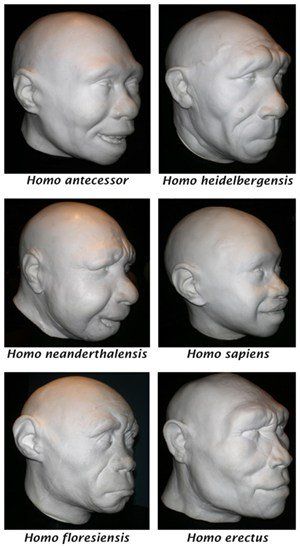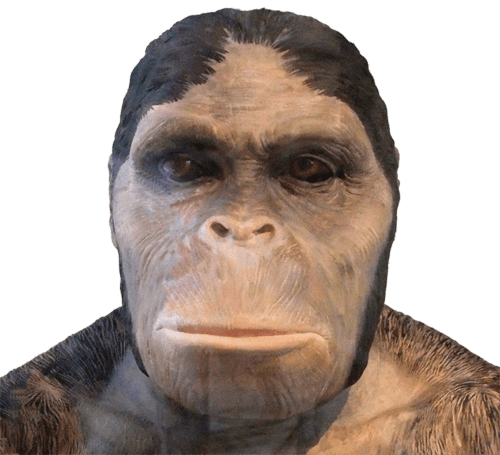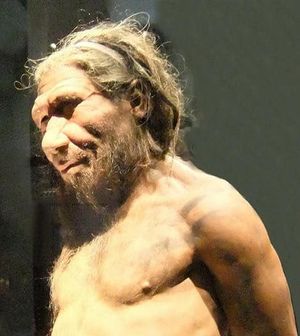On 18 December 2015, the British Museum of Natural History opened their new ‘Human Evolution’ exhibition. A few days later, I travelled to London to take a look.
The exhibition began with the usual assertion of ‘the fact of evolution’, with a sign which read, ‘The fossil record shows that the human family tree is made up of many ancient relatives, and that ape-like ancestors evolved into us’.
Most significantly, however, it went on to say, ‘Exactly who our direct ancestors were within this family tree is a subject of scientific debate’, and this admission was reflected throughout the exhibition.
Admission
Speaking of the first display, museum palaeontologist Professor Chris Stringer commented, ‘Well, we’ve attempted here to represent about 7 million years of human evolution on one diagram and you’ll notice a lot of skulls there with different species names…
‘But you’ll notice also, unlike many of these depictions, we haven’t joined them up with lines of ancestors and descendents and that’s a reflection of the uncertainty about how these forms are related…’
Also significant is that the chart contains just two main groups, one identified as ‘humans’ and other as ‘australopithecines’, with nothing bridging them. In other words, despite there being supposedly a lot of different species, he had found it impossible to put them in an order showing a clear evolutionary progression from ape-like creatures to man.
‘Species’ such as Homo neanderthalensis (‘Neanderthal man’) and Homo erectus (‘Peking man’) are described as ‘humans’, with just one species, Homo sapiens, in the subgroup, ‘modern humans’. Species such as Australopithecus afarensis and Australopithecus africanus are described as ‘australopithecines’.
Since ‘australopithecine’ means ‘southern ape’, one might reasonably conclude that all these different ‘species’ (collectively known as ‘hominins’) should be classified as either ‘apes’ or ‘humans’, with no clear examples of ‘ape-men’.

Further inside the exhibition are reconstructions of the heads and faces of various ‘human species’: Homo sapiens, Homo erectus, Homo neanderthalensis, Homo antecessor, Homo heidelbergensis and Homo floresiensis. What is so striking, however, is their similarities rather than their differences.
They are all, clearly, so very human. In contrast, the fossil skulls of australopithecines are so clearly ape-like. Again, where are the transitional forms linking australopithecines to humans?
Towards the end of the exhibition there is a full reconstruction of a ‘Neanderthal man’, leaving no doubt that, despite all that’s been said about this ‘species’ in the past, the museum scientists understand him to be fully human.
Scientism
Given their difficulties identifying a plausible evolutionary progression showing how australopithecines slowly turned into humans, how can evolutionists be so confident that this is what actually happened? The answer, I have come to see, has very little to do with science.
Why are so many scientists convinced of evolution? First, evolutionists are committed to the doctrine of ‘philosophical naturalism’ (otherwise known as scientism or materialism) — the belief that everything can and should be explained only by natural processes.
According to Professor Paul Davies, ‘Science takes as its starting point that life wasn’t made by a god or a supernatural being; it happened unaided and spontaneously, as a natural process’.
Second, living apes and humans share many similarities and this is taken as proof that we share a common evolutionary ancestor. A book on sale in the museum’s shop is titled 99 per cent ape: how evolution adds up, and argues that our DNA differs from that of chimpanzees by only 1 per cent.
Third, they believe the rocks to be millions of years old and that the fossils they contain document the long history of life on Earth. Remains of creatures found in deeper rocks are understood to be older, and therefore the ancestors of those found nearer the surface.
In their thinking, australopithecine fossils are found in rocks millions of years older than human fossils, so we must have evolved from them.
True science
Modern science flourished in the seventeenth century, because people came to see the universe as being governed by natural laws which act consistently from one day to the next.
Rainbows, for example, were understood to appear in the sky, not because a god had supernaturally put them there, but because natural processes had produced them. Based on this thinking, seventeenth century scientists such as Isaac Newton sought to discover these laws and, wherever possible, state them in mathematical terms.
People like Prof. Davies (cited above) take this thinking one step further. They argue that, not only is the universe today governed by natural laws, but also that it came into being through natural laws.
For them, it is axiomatic (self-evident) that the origins of space, galaxies, stars, planets and even life on Earth can all be explained without reference to the act of a supernatural being.

This, however, is not science but scientism, because no experiments or mathematics or logic have ever shown it to be true. It is simply what some people have chosen to believe. Significantly, this worldview is quite different from that held by many of the founders of modern science.
People like Newton believed in a special creation and a universe which, having been produced supernaturally, would thereafter be governed by natural laws. In fact, Newton himself was a biblical creationist and accepted the account of the origins taught in the book of Genesis.
Does sharing DNA with chimpanzees prove evolution? Even if humans did share 99 per cent of their DNA with chimpanzees, this would not prove that we share a common evolutionary ancestor. A perfectly reasonable alternative explanation could be that we share a common designer.
Nor would it demonstrate that we are 99 per cent chimp. We share 50 per cent of our DNA with bananas, yet we are clearly not half banana! In fact, the figure of 99 per cent similarity is outdated and many evolutionists would agree that it is far lower than this — perhaps no higher than 81 per cent. Remarkably, scientific papers as far back as 2007 refer to the ‘myth of 1 per cent’. If we consider just the Y chromosome, the chimp has only two-thirds as many distinct genes or gene families as humans and only 47 per cent as many protein-coding elements as humans.
Radioactive dating
Are the rocks really millions of years old? Evolutionists claim that this is an indisputable fact of science, based mainly on radioactive dating. What they don’t tell people, however, is that different radioactive dating methods can lead to very different conclusions about the age of the samples being tested.
For example, some wood was found buried in basalt rock in the Crinum coal mine in Australia. The wood was dated by the radiocarbon method and yielded a result of around 45,000 years. The basalt was dated by the Potassium-Argon method and yielded a result of 45,000,000 years.
Moreover, numerous scientific observations point to the rocks being far younger than evolutionists claim. Particularly strong evidence for the fossils not being millions of years old arises from the discovery of preserved organic material in dinosaur remains. This material includes DNA, proteins, blood vessels, soft tissues and blood cells. None of these would be expected to last millions of years.

Biblical creationists argue that the majority of the sedimentary rocks were laid down in the great Flood recorded in Genesis 6–8. Most, if not all, of the australopithecine fossils might be understood to be the remains of creatures that were buried at this time. The human fossils are understood to be post-Flood, and many are thought to be the remains of people who perished in caves soon after the dispersion from Babel — hence the term ‘caveman’.
We would agree with the museum’s classification of the fossils into these two groups (australopithecines and humans), although we would not say the different humans belonged to different species. Significantly, studies of DNA samples have shown that Homo neanderthalensis and Homo erectus both interbred with modern humans, making clear that they were not separate species.
Some modern humans have Neanderthal-like features, such as a pronounced brow ridge and a sloping forehead, an example being the Russian boxer, Nikolai Valuev.
Why does it matter?
If we are simply products of a mindless evolutionary process, then we are nothing more than bags of chemicals. If so, then we have no more value than bacteria and we are not responsible for our actions.
Moreover, our desires — whatever they might be — must be perfectly natural, because that’s how evolution turned us out. Can you imagine telling this to a group of teenagers?
If human life is of no greater value than that of plants or animals, then abortion, euthanasia, experiments on embryos and human cloning are all perfectly reasonable.
In contrast, if we carry the image of God, as the Bible teaches (Genesis 1:26–27), then we have great value and a responsibility to honour that image in ourselves and others. To deface it by hurting others is a crime against God and against humanity. To abort a baby or to deliberately end the life of an elderly person is to ‘play God’.
How we view ourselves will be greatly influenced by what we believe about our origins. Museums and churches, therefore, should be very careful what they teach about these things.
Dominic Statham BSc, DIS, MIET, CEng worked for Rolls Royce on projects for the Panavia Tornado and Eurofighter Typhoon, and for GKN engineering drivelines for Jaguar and Land Rover vehicles. He has extensive experience of product development and holds a number of patents. He is a speaker and writer for Creation Ministries International (CMI). This CMI article is used with kind permission (for references, notes and further reading, see: http://creation.com/image-of-god-or-ape).






